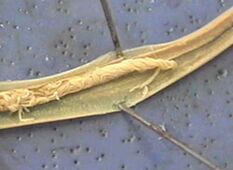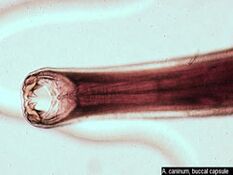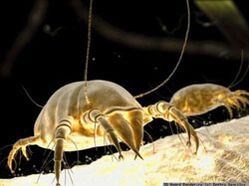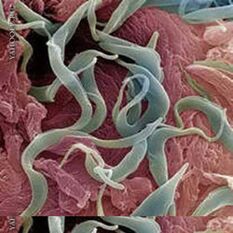Many people leading a healthy lifestyle have health problems due to the presence of parasites.The highlighting of the body (appropriate nutrition, physical exercises, hardening procedures) without eliminating the body of parasites does not give a pronounced positive effect.According to the World Health Organization, helminths are located not only in the gastrointestinal tract, but also in vital organs: brain, heart, lungs, liver, kidneys.Helminthes in the processes of their lives distinguish special substances - toxins which are strong poisons and allergens.It is the simplest mushrooms, fungi and helminths which are the trigger mechanism of many chronic diseases: cholecystitis, cholelithiasis, pancreatitis, colitis, diabetes mellitus, bronch asthma, atopic dermatitis.

Chronic fatigue, irritability and anxiety, hyperactivity in children, anemia, brittle nails and hair, problem skin, headache, appetite disorders, reduction in immunity - it can be the signals of the current disease.With a long stay of parasites in the human body, the immune system suffers greatly.In the process of a constant fight with foreign antibodies, it is exhaustion, that is to say the development of secondary immunodeficiency.The disease with parasites leads to hypovitaminosis, the exhaustion of micro-elements: potassium, copper, manganese, selenium, zinc, magnesium, silicon;The violation of hematopoiesis, hormonal insufficiency, vascular permeability is raped, protection against body cancer suffers.
For millennia, people, mainly foods, have received natural antimicrobial, antiparasite and antiviral substances.A decrease in the consumption of wild plants, fruits, berries, replacement of their vegetables and their fruits, thermal and industrial treatment has led to a decrease in the consumption of natural volatils and antibiotics.As a result, a person has become easy prey for many microorganisms.The intensive development of the pharmaceutical industry which produces antibiotics has resulted in a decrease in immunity.
Determination of parasites

Parasites (from Greek. Parasitos - overlap, a parasite) - lower plant and animals living outside or inside another (owner) and to eat at its expense.Parasites appeared in the process of historical development of organisms from freely living forms.Their adaptation to certain living conditions involved the simplification of their organization, the development of special fixing organs, increased development of genitals, breathing, which makes it possible to exist in an impassive environment.Parasites include many helminthes, fungi, viruses, protozoa, verse, crustaceans, spider insects.PARASIME owners can be bacteria, the simplest, plants, animals and humans.Parasites undergo a complex development cycle: sometimes they need a change of 2-3 owners whose body is intermediate (the helminths pass the larval stages) or the final (the helminths become mature, invasive).Parasites cause weakening and exhausting of the host body, cause a number of diseases.
Helminants can parasitize in all the tissues and organs of a person, but the most common place of their location is the food tract.Tauple of bull and pork, a wide strip is fixed in the upper small intestine, also parasitic ascaria.The dwarf tabhell is mainly located in the lower third of the small intestine, the Vlasov - in the large intestine, opistorchis - in the bile passages of the liver and the pancreas conduits, the pine worms - in the lower parts of the thin and in all parts of the large intimate.Thus, the distribution of different types of helminthes along the digestive tract in search of the most favorable living conditions provides them with individual survival and creates the development conditions of several types in the body of a single person.
Classification
By distribution:
- Ubiquette - Meet everywhere.
- Tropical - distributed in tropical climatic areas.
Depending on the biological and epidemiological characteristics: GeohelMinths - a disease in which the helminths develop first in the human body, then on an unwanted substrate, more often in the soil.Biohelminthes are a disease in which a biological cycle for the development of helminths necessarily takes place in the body of other living beings, with the exception of a person.To distinguish the finale owners, in the body whose helminths develop at the sexually mature stage, as well as the helminths, where the parasite is at the stage of the larva or its reproduction is not sexually.A person is more often the final host, less often - intermediate.Connection Helminythiasis is a disease in which parasites are distinguished from the human body at mature mature, following which the infection of another person is possible or re-infection of himself.
Depending on the location of the parasite in the body: Education - Living in the intestinal cavity and other cavities of a person (for example, ascarids, adhesive tape) and tissues - living in tissues.

In place of the stay on the owner:
- External (mosquitoes, blinds, leeches, lice).
- Internal (helminthiasis):
- Rounds (nematodes - ascarids, vlasov, pine, strungyloids);
- Dishes:
- Trematodes (saucers - Cat bickelter, schistosomes);
- CESTODES (Towards of the ribbon - Ténia de Taureau and Porc, dwarf tabbell, wide ribbon, echinococcus).
- Bacteriosis (Staphylococcus, Streptococcus).
- Protosis (Amibas, Lamblia, Trichomonas, often owners of chlamydia and AIDS virus).
- Mycosis (fungal diseases) - For example, Candida.
How parasites adapt
- a long life expectancy (the helminths live in the body for years, and sometimes as much as the owner of parasitic life);
- The ability to remove or modify the immune response of the host body (a state of immunodeficiency occurs, conditions are created for the penetration of pathogens from the outside, as well as to relaunch the internal foci of the infection);
- Many types of helminthes, entering the digestive tract, distinguish anti-enzymes, which saves them from death;The digestion process is disturbed, toxic-allergic reactions which are different in gravity appear: hives, bronchial asthma, atopic dermatitis;
- Development stage (egg, larva, change of owners);
- the ability of eggs for years to persist in the external environment;
- Sexual reproduction in which genetic information exchange, and it is the highest stage of development, leading to an increase in the heterogeneous population, that is to say that parasites become less vulnerable;
- The absence of immunoproprophylaxis methods because the immune response is low and unstable;
- Helminthes widespread, many habitats (water, soil, air, plants and animals).
How parasites enter the body

You can be infected not only through dirty hands.Animal hairs are a wearer (ascaride), Lamblia.The pine worms that fell from wool remain a viability up to 6 months and through dust, toys, carpets, underwear and bedding and hands fall into the food tract.The dog by damp breathing disperses the eggs at a distance of 5 meters (cat - up to 3 meters).Dog fleas also tolerate verse eggs.Askarid eggs enter the body through poorly washed vegetables, fruits, berries, green vegetables, dirty hands and are also distributed in flies.And a barbecue wrongly incorrectly cooked or a house in the house is the path of infection by trichinellosis;Badly salty fish, caviar - opisthorchiasis and adhesive tape.
There are therefore several ways to enter the body:
- Food (through infected foods, water, dirty hands);
- Contact-household (through household items, infected family members, pets);
- through blood -based insects;
- Active (in which the larva penetrates through the skin or mucous membranes during contact with infected soil, during bath in open tanks).
Prevention
Here are some rules that must be followed in order to prevent the penetration of parasites into the body:
- It is not recommended to drink water from natural sources and in an unknown area.
- You cannot eat non -washed vegetables and fruits.
- It is advisable to be wary of mosquitoes, ticks and other insects that can be carriers.It is necessary to use special means of protection against them, and in places where there are many, wear pants and long -sleeved shirts.
- Before a trip to some countries, it is necessary to vaccinate typhoid, plague, tropical fever and other infectious diseases.By going to the places where the mosquito for malaria is located, you must take anti-male tablets.Bringing together on a long journey, where ticks can be, it is important to vaccinate from the encephalitis born to the tick.
- Do not allow children to hug and embrace dogs, cats and other pets. Take care of pet health - take them from department lessons.
- Follow the rules of personal hygiene, maintain the cleanliness of the house.
- Give periodic preventive antiparasitic courses to the whole family.
Children and parasitic invasions

Children are children most vulnerable to the effects of parasites.They are infected with various types of parasites through dirty hands, sand, soil and water.Sometimes, child infection can occur in intrauterine, because the simplest larvae, bacteria, viruses, candida and helminths can penetrate the fetus through the placenta with blood flow, as well as when the birth channel is born.Due to the expansion of their motor activity, at the age of 1.5 to 3 years, children can be infected at home, for walking, in kindergarten during contact with polluted objects (street shoes, floor, toys, common spaces), in the street (playing in the sandbox or in the soil), as well as on contacts with animals (vagabonds or home in the street).The high probability of invasions by parasites is observed without compliance with the hygiene rules (unwashed hands, eat vegetables and unwashed fruits, eat raw water in natural ponds and swim in them).Only pine eggs and dwarf tenia are transmitted directly from person to person.Eggs from other helminthes for maturation must necessarily enter the body of an intermediate host or an appropriate environment - soil or water.At the age of 1.5 to 3 years, the extent of the infection of children with helminths can reach 80%.
More than 90% of all Helminthic Diseases in children are caused by intestinal nematodes that parasitize in the intestines (ASCARIS, PINWORMS), parasitic nematodes in the intestinal wall or other organs (ankylostoma, non -ciciminal and an intestinal utectum) are less common.In children, subjected to elementary hygiene (improvements of meat or fish treated raw or thermally insufficiently insufficient, vegetables and unwanted fruits, unploded water from natural tanks), there are practically no worms (trematodes) and band helminthes (cestodes).
How can a child be infected?
The infection is carried out when the egg larvae penetrate the body.Eggs enter the environment with excrement of infected people and animals.They have microscopic dimensions, are very resistant to various influences and can maintain vitality for a long time outside the body (in the soil, on the surface of objects or products, in the folds of linen, on the skin).Once in the oral cavity of the child, the eggs of worms pass, partially destroying, through acid, the aggressive environment of the stomach and activated in the intestines, where the conditions of adult development from eggs are the most favorable.Purchase and preschool children are particularly sensitive to Helminthic invasions because they still have imperfect barriers of the gastrointestinal tract.
Measures for the prevention of helminthiasis in children: for all family members to comply with hygiene rules, try to prevent close contact of the child and their personal effects with pets;In the street, it is important to ensure that the child does not select various objects;prevent contact with animals;It is important to instill in children with personal hygiene skills (wash your hands with soap after the street and visit the toilets);It is advisable to periodically carry out a damp cleaning at home, to wash with soap toys, especially in the presence of pets, as well as toys from the house walking;Vacuum cleaner carpets, padded furniture and padded toys;Do not give the child the vegetables and the unwanted fruits, not the meat and the sufficiently thermally unprocessed fish, the raw water of the natural tanks.
Signs of Helminthic invasion in children

Most often, a child must guess the Helminthic invasion by indirect signs.The probability of invasion of the Helminthics is very high if the child has such symptoms such as: salivation, nausea, a decrease in appetite or a pathological increase, establishment pain around the navel or without a certain location, appearing independently of food admission, stool disorder (diarrhea, constipation), frequent topoure or distribution,Evening, whims without causality, a poor asleep and a poor night sleep, accompanied by cries, awakening, "waving", grinding teeth, itching in the perineum.Often, parasites lead to an allergicization of the body, skin reactions appear in the form of atopic dermatitis (as a rule, it is obstinate, which is difficult for symptomatic therapy).If worms are in a child or in one of the family members, it is necessary to treat the whole family in order to avoid the training of the infection.In this situation, it is important to strengthen hygienic measures, in particular, boiling and iron on both sides and personal underwear.
























